| The algae are an ancient group of aquatic plants. Some taxonomists consider the algae to be Protoctists but this approach will not be followed here. There are thought to be about 23,000 species of algae. |
| There are 3 features which distinguish the algae from other plants;- |
| Body plan: There is no specialisation of the algal body into root,
stem, leaves with vascular tissue. The photosynthetic portion of the alga is a thallus
while the attachment portion comprises hair-like rhizoids. For this reason, old
classification systems put the algae into a grouping known as the Thallophytes. |
|
| No Embryo: For most algae, sperm and eggs fuse in the open water and the
zygote develops into a new plant without any protection. For other plant groups the zygote
develops into an embryo within the protection of the parent plant. For this reason, old
classification systems termed all other plant groups Embryophytes. |
|
| Reproductive structures: The gametes are produced within a single cell.
There is no jacket of sterile cells protecting the gametes. |
| Release of algal sperm cells from a single cell | Moss egg cell surrounded by sterile cells |
|---|
Being aquatic, algae are
Terrestrial algae are effectively surviving in an aquatic environment on
land. Soil algae survive in a film of soil water.
The other major group of terrestrial algae are those in lichen symbioses.
| Lichens comprise algae and fungi in partnership. The fungus provides an outer weft of mycelia which creates a humid protected environment for the alga to live and photosynthesise (and feed the fungus!). | 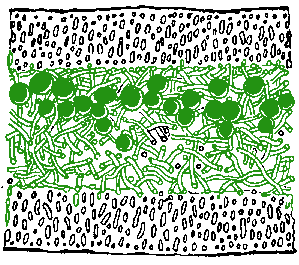 |
Fungal layer Algal layer Fungal Layer |
Interestingly, lichens have distinctive morphologies and so these associations have
traditionally been given
genus & species names as if they were discrete organisms.
| Crustose lichen on rock | Fruticose lichen |
|---|
| As terrestrial plants the algae have a unique role as pioneer plants. They grow on
bare rock, providing there is moisture. The rock weathers and crumbles. The algae die. The
mineral contribution of the rock and the organic remains of the algae lead to formation of
soil. This pioneering activity therefore paves the way for more demanding plants to
invade. A succession such as this is precisely what would have occurred when the islands
of the Caribbean first emerged from the sea. Within the aquatic environment, there are two broad niches;- |
| planktonic - floating algae. For micro-algae these often have strange shapes which help keep the algae suspended as well as serve an anti-predation role. benthic - attached
algae. |
| Algae are primary producers, i.e. they are the start of the food chain. One third of
all the carbon fixed on this planet is achieved by algae, largely in the oceans! |
|
| Algae under particular nutrient-rich conditions may grow disproportionately causing
potentially harmful algal blooms. |
|
| Seaweeds are used as fertilisers and even food (by the Japanese, Irish, Welsh and
even some of us here in the Caribbean who enjoy "sea moss" ). |
|
| Extracts from the cell walls of (typically brown & red) algae provide the
polysaccharides agar and carageenan. These are used as thickening agents in food, in
surgical dressings and in microbial media. |
|
| Diatomaceous earth. The skeletons of a group of algae, the diatoms, are glass-like and this material is put to a variety of uses, such as abrasives (it used to be used in toothpaste!), reflective road signs, swimming pool filters. |
A suspension of
diatoms
Algae are largely classified on the basis of:-
The algae are a very heterogeneous grouping. Traditional taxonomists have considered each group (greens, reds etc) a division which means that while all algae share the feature of being simple plants, "reds" are as distinct from "browns" as ferns are compared to flowering plants! One fundamental difference between algal groups is the structure of the chloroplast. Green and red algae have simple plastids with 2 outermost membranes while the other algal groups have complex plastids with 3 or more bounding membranes. |
You should consult handout 3,
summarising the characteristics of the major algal groups.
Click here, if you want to
look at photomicrographs of various algal groups.
Believe it or not there are even amateur algae hunters
out there!
In this course we will focus on three groups
Nevertheless, there are other groups you should be aware of.
These are closest to the higher plants in many ways and are considered their ancestors
as they share
common features:-
This is a very diverse group, showing almost the full spectrum of morphological
possibilities - from unicells to macroalgae.
We will look at this in our next topic, Algal Structure &
Reproduction.
 |
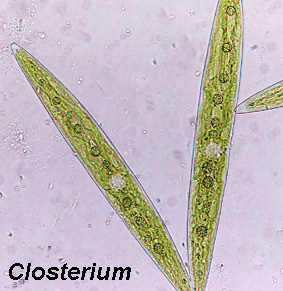 |
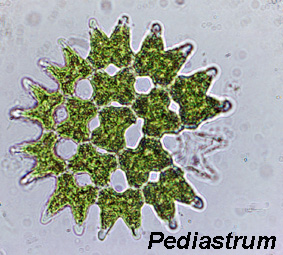 |
Algal images courtesy of Dr. Morgan Vis (see his Ohio University Algae Home Page)
| Euglena is probably the best-known member of this group of unicellular flagellates. These Euglenoids resemble green algae in their photosynthetic pigments (chlorophylls a & b, ß-carotene) but |
 Euglena photo used with permission of Dr. Richard E. Triemer. |
Euglena
Euglena can cause algal blooms. |
|
These are the brown algae.
Sargassum on an exposed shoal |
|
| These are the golden-brown algae. Link this group in your mind to the brown algae. They share many of their features (same pigments, same storage reserves) but occupy a different niche - they are microscopic and planktonic unlike the browns which tend to be attached seaweeds. In fact, some taxonomists put the brown and golden-brown algae in the same Division. |
|
Diatoms are probably the most important members of this group. They have an outer case or frustule made |
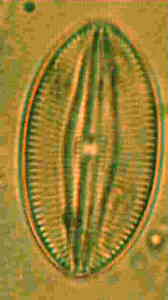 |
Click here
for a great introduction to diatoms or click below for more details on this group
http://www.bgsu.edu/Departments/biology/algae/index.html
http://www.comet.net/gek/phytoc.htm
http://hjs.geol.uib.no/html/diatoms/
| These are the red algae and are mainly marine macro-algae (seaweeds). They have;-
|
| This is Gracilaria,
known in the Caribbean as "sea moss". As botanists, avoid this name as
"moss" has a very precise botanical meaning, viz. a group within the Bryophytes!
Gracilaria is dried and boiled to provide a drink or dessert, supposedly with health-giving (even aphrodisiac!) properties. |
This is a diverse group of reddish-brown micro-algae. They inhabit both freshwater and
marine habitats.
The most important group within the Pyrrophytes is probably the dinoflagellates.
Dinoflagellates;-
|
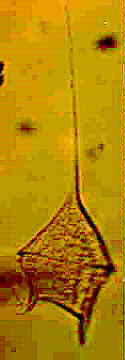 |
Click here
for some fantastic scanning electron micrographs of dinoflagellates.
| We have
now had a look at the main taxonomic groups in the Algae. Click the button to move on to their structural & reproductive diversity. |
![]()
© C. M. Sean Carrington 1997
updated 21 September, 2000